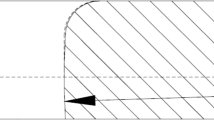Abstract
The deep drawing process is implemented for sheet metal forming in industries for acquiring the intricate shape of products and helping to maintain a high productivity rate. Failures viz. wrinkling, earing, tearing and fracture of the sheet metal, during this process are common. The aspects related to these failures are explored in this paper to reduce the occurrence of these failures. The latest method for analyzing failures is through simulation techniques in which numerical methods are combined with software packages. Different cases of failures and their corresponding method of analysis are discussed such as—effect of blank holder force, die shape, stress–strain development, contact pressure distribution, effect of die and blank holder shapes, wrinkling and fracture failures in sheet metal. Failures can be predicted from simulation for different product designs. The tool widely used for this is ANSYS which is found effective to obtain the desired results.











Similar content being viewed by others
References
M.S.B. Ismail, Experimental Study of Formability of Sheet Metal in Deep Drawing Process. (Malaysia University Pahang, Gambang, 2010)
S.T. Faris, Study of the stress and strain distribution during deep drawing process. Diyala J. Eng. Sci. 02, 80–95 (2009)
M. Kaonga, Simulation and Optimization of a Full Deep Drawing Process. (The University of Zambia, Lusaka, 2009)
L.M. Nimbalkar, S. Mangshetty, Analyzing the effect of blank holder shape in deep drawing process using fem. Int. J. Eng. Res. Dev. 4(1), 23–28 (2012)
S.V. Kumbhar, Pressure optimization and failure prediction for deep drawing process of sheet metal products: a case study. J Fail. Anal. Prevent. (2018). https://doi.org/10.1007/s11668-018-0485-6
S.V. Kumbhar, B.K. Sonage, Enhancement of thermal efficiency and cost effectiveness by development of melting furnace by revamping and troubleshooting fuel-fired furnace. Heat Transf. Asian Res. 48(1), 164–181 (2019). https://doi.org/10.1002/htj.21377
S.V. Kumbhar, B.K. Sonage, Unsteady-state lumped heat capacity system design for tube furnace for continuous inline wire annealing process. Heat Transf. Asian Res. (2019). https://doi.org/10.1002/htj.21411
S.V. Kumbhar, M.M. Salotagi, Technological developments in annealing furnaces for performance improvement. Int. J. Adv. Res. Innov. Ideas Educ. 3(3), 3419–3430 (2017)
R. Uday Kumar, Analysis of major strains and minor strains in sheet metal forming. Int. J. Appl. Innov. Eng. Manag. (IJAIEM). 2(2), 194–198 (2013)
K.M. Abed, A design calculating system for deep drawing die by using simulation model. Thi_Qar Univ. J. Eng. Sci. 2(4), 1–15 (2011)
J. Malekani, A.M. Pour, M. Eskandazade, A. Totonchi, Numerical and experimental investigation of die and blank holder shape in deep drawing process. J. Appl. Sci. 8, 2153–2157 (2008)
M.A.B.M. Shaufi, Optimization of Process Parameters in Sheet Metal Forming by Using Taguchi Method. (Universiti Malaysia Pahang, Gambang, 2008)
R. Uday Kumar, P.R. Reddy, Influence of viscosity on fluid pressure in hydroforming deep drawing process. Int. J. Mech. Eng. Technol. (IJMET). 3, 604–609 (2012)
R.V. Reddy, T.A. Janardhan Reddy, G.C.M. Reddy, Effect of various parameters on the wrinkling in deep drawing cylindrical cups. Int. J. Eng. Trends Technol. 3(1), 53–58 (2012)
J. Wang, A. Goel, F. Yang, J.-T. Gau, Blank optimization for sheet metal forming using multi-step finite element simulations. Int. J. Adv. Manuf. Technol. 40, 709–720 (2009)
M.M. Moshksar, A. Hosseini Kalvarzi, Ironing of aluminum cups. Mater. Manuf. Process. 16(4), 461–470 (2001). https://doi.org/10.1081/AMP-100108520
Funding
No funding has been received from any organization/institution, neither any grants received. The full work is self-supported.
Author information
Authors and Affiliations
Corresponding author
Ethics declarations
Conflict of interest
The author declares that he has no conflict of interest.
Additional information
Publisher's Note
Springer Nature remains neutral with regard to jurisdictional claims in published maps and institutional affiliations.
Rights and permissions
About this article
Cite this article
Kumbhar, S.V. Case Studies in Failure Analysis Through Simulation of Deep Drawing Process of Sheet Metal Products: A Brief. J Fail. Anal. and Preven. 21, 1575–1581 (2021). https://doi.org/10.1007/s11668-021-01207-6
Received:
Revised:
Accepted:
Published:
Issue Date:
DOI: https://doi.org/10.1007/s11668-021-01207-6




